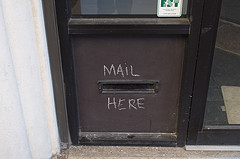Forget The NSA’s Hi-Tech Snooping, The USPS Has Been Scanning Our Mail For Years
The NY Times has a good piece on the Mail Isolation Control and Tracking program, which was put into place following the post-9/11 anthrax mailings. It quite literally scans every envelope, post card, and piece of junk mail — some 160 billion pieces of mail a year. These scanners probably know more about the mail you receive than you do.
The Mail Isolation program is really just a super-beefed-up version of the USPS “mail covers” program that has been around for about a century, explains the Times. Mail covers are warrantless requests for photos of the outside of specific recipients’ mail.
Basically, a law enforcement agency fills out the request, and for 30 days (extendable to 120 days), it receives scans of all mail related to the subject of the request. Only the outside of the mail is provided, as opening mail would require a warrant. Authorities maintain that no warrant is needed for information on the outside of a piece of mail, as there can be no reasonable expectation of privacy. The USPS can deny a mail covers request, but rarely does.
Postal Service sources tell the Times it gets around 15,000 to 20,000 mail covers requests a year related to suspected criminal activity. There are also requests related to national security concerns, but no numerical data is available on those.
That sounds an awful lot like the not-very-transparent transparency reports issued by companies like Apple, Microsoft, Google, and Facebook in the wake of the NSA revelations. Those companies released statistical data on requests for customer information related to law enforcement, but were not permitted from revealing information about classified requests from federal agencies.
A former FBI agent explains to the Times the benefits and potential concerns about the mail-scanning program.
Calling it “a treasure trove of information,” he explains that you can glean a lot of details just from sifting through a person’s mailbox. “I can see who you bank with, who you communicate with — all kinds of useful information that gives investigators leads that they can then follow up on with a subpoena.”
However, he cautions that a virtually unregulated system like this “can be easily abused because it’s so easy to use and you don’t have to go through a judge to get the information. You just fill out a form.”
Want more consumer news? Visit our parent organization, Consumer Reports, for the latest on scams, recalls, and other consumer issues.


